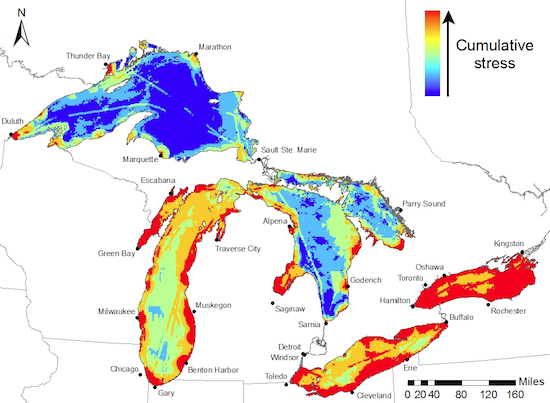Mapping effort charts restoration tack for Great Lakes

Maps like these could help guide new remediation efforts for the Great Lakes. The maps show where environmental stress is greatest and where combinations of environmental factors — pollution, invasive species and climate change — are having their greatest impacts.
Map: Great Lakes Environmental Assessment and Mapping Project
As the federal government builds on its $1 billion investment to clean up and restore the Great Lakes, an international research consortium has developed innovative new maps of both environmental threats and benefits to help guide cost-effective approaches to environmental remediation of the world’s largest fresh water resource.
Writing this week (Dec. 17, 2012) in the Proceedings of the National Academy of Science (PNAS), a group led by researchers at the University of Michigan and the University of Wisconsin–Madison reports on an expansive and detailed effort to map and cross-compare environmental stresses and the ecological services provided by the five lakes, which together encompass more than 20 percent of the world’s fresh surface water.

McIntyre
“This study provides a benchmark for understanding restoration in the Great Lakes,” says Peter McIntyre, an assistant professor at UW–Madison and one of the report’s senior authors. “Until now, restoration has usually been dominated by a piecemeal approach, but our team’s synthesis of all major classes of environmental problems provides a more comprehensive perspective.”
The Great Lakes basin, home to more than 30 million people, provides drinking water and recreation for millions of people in both the United States and Canada. In addition, the lakes support a host of environmental services ranging from fishing to boating, beach combing to birding, with economic values estimated in the tens of billions of dollars annually.
The lakes are under severe environmental stress from decades of urban, industrial and agricultural runoff pollution, as well as a continuing onslaught of invasive species, climate change and other problems.
“Despite clear societal dependence on the Great Lakes, their condition continues to be degraded by numerous environmental stressors likely to have adverse impacts on species and ecosystems,” says David Allan, lead author of the report and an aquatics professor at the University of Michigan’s School of Natural Resources and Environment.
The new report was produced by a consortium of scientists from nine U.S. and Canadian universities as well as from key government agencies and private conservation organizations. It provides an overall index of the environmental stresses affecting the lakes and, critically, summarizes the information in high-resolution maps of the intensity of environmental problems. The analysis accounts for the impact level of each stressor, which was estimated by surveying 161 scientists and resource managers from across the Great Lakes region.
The study highlights where in the lakes environmental problems are most acute. Areas with the highest levels of cumulative stress, drawn from a list of 34 environmental stressors, include large swathes of Lakes Erie and Ontario, and portions of Lakes Michigan and Huron, including Green Bay, Saginaw Bay and virtually all of the coastal waters of Lake Michigan. By contrast, offshore areas of Lakes Superior and Huron, where human population and development are not as concentrated, exhibit lower environmental stress.
“The Great Lakes have been dying a death of a thousand cuts,” says McIntyre. “The maps we’ve produced, the first of their kind, can help us devise better ways to stem the bleeding.”
Indeed, the team reports that many different combinations of environmental problems lead to the degradation observed around the Great Lakes, with most areas experiencing at least a dozen different types of challenges.
“What our team has done is to gather the best data on each of these stressors, and put it all together in a cumulative way,” explains McIntyre, who began work on the study as a post-doctoral fellow at the University of Michigan and is now a professor at the UW–Madison Center for Limnology.
At present, the federal government’s Great Lakes Restoration Initiative has successfully identified many high-stress sites where particular environmental problems such as toxic chemicals or an invasive species are highly visible. Such remediation efforts, the authors of the new report argue, can be further enhanced by accounting for the full range of environmental stresses at these priority sites, thereby avoiding the risk of cleaning up one problem only to find that others continue to degrade the ecosystem.
“The Great Lakes have been dying a death of a thousand cuts. The maps we’ve produced, the first of their kind, can help us devise better ways to stem the bleeding.”
Peter McIntyre
In addition to identifying environmental problems, the team led by Allan, McIntyre and Sigrid Smith, also of the University of Michigan, mapped where in the Great Lakes key environmental services – such as recreational fishing, marinas, beach use and bird watching – reside. The resulting comparative analysis shows a startling overlap of threats in areas where the services are the highest.
“We looked for a nexus between our threat maps and service maps,” says McIntyre, “and were shocked to see that most of the high service sites are also on the high end of the threat spectrum.”
The new analysis and the resulting maps of Great Lakes environmental stresses and services set the stage for a new generation of restoration efforts, the study authors write in the PNAS report. The study highlights, for example, the potential to broaden the current portfolio of restoration projects by identifying locations of high cumulative stress not currently targeted for restoration. In addition, the maps detail areas of low stress that could be protected by mitigating just one or a few problems.
“Basically, our work systematically inventories the laundry list of things that need to be fixed and where they occur,” says McIntyre. “This information can then be used in any given location by local officials and citizen groups.”
The new study, known formally as the Great Lakes Environmental Assessment and Mapping Project or GLEAM, was initiated at the University of Michigan and was supported by the Fred A. and Barbara M. Erb Family Foundation. Additional funding for the study was provided by the Nature Conservancy’s Great Lakes Fund for Partnership in Conservation and Economics, and the University of Wisconsin–Madison.




